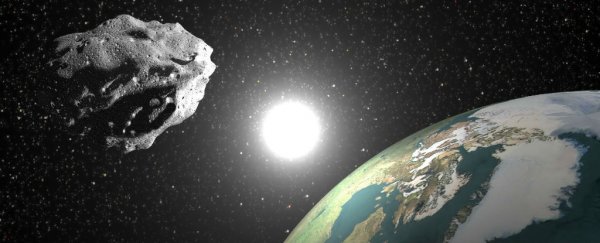A former Microsoft chief technologist has just come out and accused NASA of making some fundamental mistakes in their assessment of the size of more than 157,000 near-Earth asteroids.
Nathan Myhrvold, now a billionaire patent collector, has published a paper saying that NASA's statistics on the size of these asteroids is riddled with errors, telling Science magazine, "None of their results can be replicated. I found one irregularity after another."
Before you start freaking out about an impending asteroid collision, let's all keep in mind that when it comes to the possibility of a giant hunk of rock hurtling through space, colliding with Earth, and obliterating everything we know and love, research has shown that the chances are only around one in 10,000.
That means the human race is more likely to succumb to a deadly supervirus than being crushed by a 5-km space rock, which isn't the most comforting thought, but does tell us where our priorities should lie.
Having said that, a threat's a threat, and we all take for granted the fact that NASA has a bunch of experts keenly watching the space around us 24/7 for any signs of something big enough to hit us.
The only problem is that maybe they don't know as much about these lurking asteroids as we thought they did?
"The bad news is it's all basically wrong," Myhrvold told Kenneth Chang at The New York Times. "Unfortunately for a lot of it, it's never going to be as accurate as they had hoped."
When he left Microsoft in 1999, Myhrvold made a fortune as what some describe as a "patent troll" - his company Intellectual Ventures acquires patents so it can charge technology companies license fees.
The Princeton physics graduate has also made quite a name for himself as a self-styled 'statistics cop', most notably accusing Florida State University palaeontologist, Gregory M. Erickson, of making serious errors about the growth rates of dinosaurs in several peer-reviewed papers - two of which had been published in Nature and were subsequently corrected.
"Having somebody like Nathan having a different perspective and different background coming in and looking at it with fresh eyes, I think there's nothing wrong with that," palaeontologist Kristina Curry Rogers from Macalester College in Minnesota, an author on one of Erickson's Nature papers, told The Times. "It makes us all think."
He's now been focussing on analyses based on data collected by NASA's Wide-field Infrared Survey Explorer (WISE) spacecraft, and a follow-on mission, NEOWISE, which are responsible for the discovery of more asteroids than any other observatory in history.
In a 2011 paper, NASA scientists reported that estimates of asteroid diameters made by NEOWISE are often within 10 percent of the actual size. But Myhrvold did his own calculations and said these uncertainties are significantly greater.
Eric Hand explains over at Science:
"Myhrvold says they made mistakes, such as ignoring the margin of error introduced when extrapolating from a small sample size to an entire population. They also neglected to include Kirchhoff's law of thermal radiation in their thermal models of the asteroids.
Based on his own models, Myhrvold says that errors in the asteroid diameters based on WISE data should be 30 percent. In some cases, the size errors rise to as large as 300 percent."
The resulting sparring match between NASA scientists and Myhrvold has gotten pretty ugly, with Ned Wright, the principal investigator for WISE at the University of California, Los Angeles, telling Science that Myhrvold's own paper, which he's published ahead of peer-review, is itself full of errors.
"For every mistake I found in his paper, if I got a bounty, I would be rich," he says.
Myhrvold responded by saying he's fixing the errors, and said they do not alter his overall findings, and accused NASA of being overly sensitive because they're in the process of funding a new asteroid-hunting telescope, called NEOCam.
"They're up for this NEOCam thing and they're afraid it looks bad. And it does look bad," he said.
Wright hit back and said he doesn't have access to Myhrvold's computer codes, "so we don't know why he's screwing up", but added that since the former exec once worked at Microsoft, he's "responsible in part for a lot of bad software". Ouch.
Unfortunately for all of us trying to make sense of wtf is actually going on here, Myhrvold decided to get his paper out to the public on pre-print website arXiv.org, while it's still in the process of being peer-reviewed for publication in the journal Icarus. So until we have the results of the peer-review process, we're in the middle of a good old-fashioned, "He said, she said."
While it should never have gotten as ugly as it has, what Myhrvold is doing is essentially the right thing - with science going through a bit of a 'replication crisis' right now, it's important that people are taking the time to check on the facts - even if those facts come from NASA. But it has to be done properly.
"I do think he's performed a really very useful service," Alan W. Harris, a senior research scientist at the Space Science Institute, told The Times, "to do the error analysis more carefully and alert people that you shouldn't just take some of the data out of the WISE table and just assume they're gospel."
The good news is that while we have to wait for the scientific process to sort itself out here, there's no need to panic over what NASA may or may not know about the size and reflectivity of these asteroids - Myhrvold himself says NASA has not overlooked the dangers posed by these lurking space rocks.
You can read his pre-print paper here.
